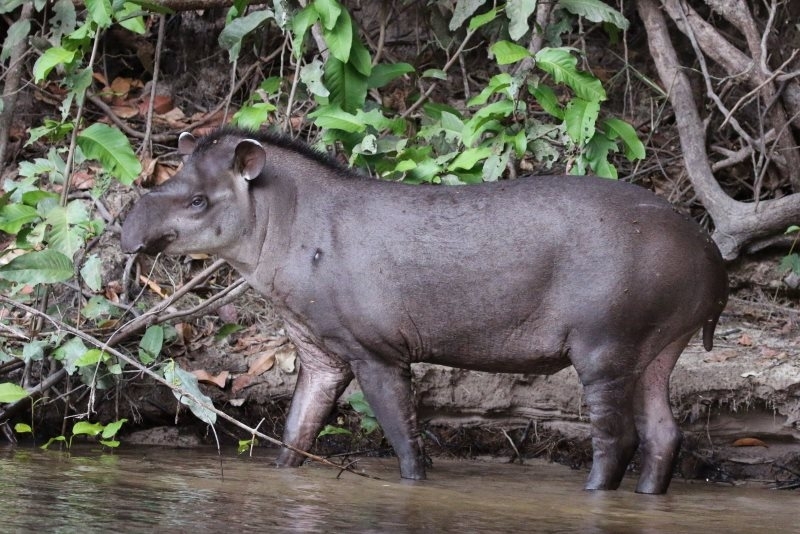


Study suggests these two species of large herbivores have complementary ecological functions, favoring seed dispersal and growth of adult trees (tapir pictured in Pantanal / photo: Charles J. Sharp – Wikimedia Commons)
Published on 05/04/2021
Agência FAPESP * – According to a team of researchers affiliated with São Paulo State University (UNESP) in Rio Claro, Brazil, the extinction of South America’s two largest herbivores – the lowland tapir (Tapirus terrestris) and the white-lipped peccary (Tayassu pecari) – would cause a significant decrease in forest diversity throughout the continent.
The results of experiments that began ten years ago showed that plant communities are more diversified in areas where both species are present and less diversified in forests inhabited by only one species. The two species have complementary ecological functions.
The study, which was supported by FAPESP, is published in the British Ecological Society’s Journal of Ecology.
It was conducted as part of the Thematic Project “Ecological consequences of defaunation in the Atlantic Rainforest”, led by Professor Mauro Galetti under the auspice of the FAPESP Research Program on Biodiversity Characterization, Conservation, Restoration and Sustainable Use (BIOTA-FAPESP).
Tapirs and peccaries used to be found almost everywhere in South America’s forests, but both species are now endangered in many localities owing to poaching and deforestation for agriculture. According to the researchers, the ecological roles of these species and their importance in the ecosystem services of the forests (biodiversity, nutrient cycling, carbon storage and maintenance of water sources, among others) are poorly understood.
Peccaries consume large amounts of seeds and seedlings. They live in large family groups that can exceed one hundred individuals. Their foraging habits and soil trampling help significantly reduce understory growth in tropical forests.
Tapirs, in contrast, are solitary and feed on leaves and fruits of several species, without affecting plant numbers. They defecate some way away from the places where they feed, moving seeds from one part of the forest to another.
“While peccaries act as small ‘tractors’, turning over the forest soil, tapirs are gentle giants that transport seeds in their stomachs. Their ecological roles are very different,” Jose Ignacio (Nacho) Villar, first author of the article, told UNESP Agência de Notícias.
Both species travel long distances in the forest, and the disturbance caused by peccaries overlaps with the seed dispersal performed by tapirs.
“Our hypothesis is that the disturbance caused by peccaries increases the likelihood that seeds dispersed by tapirs will become adult trees, favoring forest diversity on a large spatial scale,” said Villar, who has a postdoctoral scholarship from FAPESP and is supervised by Galetti.
Previous studies speculated that both tapirs and peccaries were “ecosystem engineers”, but this is the first to evaluate field data, which shows that only the combined activities of both species have a substantial positive impact on forest diversity.
“The disappearance of these herbivores from the tropical forests of South America could have significant effects on ecosystem dynamics, possibly equivalent to the eradication of elephants from African and Asian forests, or that of gnus from savannas,” Villar said. Peccaries are among the favorite prey of the jaguar (Panthera onca), the apex predator in South America’s forests, so their extinction would affect all levels of the food chain.
“We’re only just beginning to understand the consequences of mass extinction of large herbivores on tropical forests,” Villar said. “It’s the tip of the iceberg. We must generate this knowledge before it is too late. Long-term experiments like ours are essential to achieving this goal.”
The article “The cryptic regulation of diversity by functionally complementary large tropical forest herbivores” by Nacho Villar, Tadeu Siqueira, Valesca Zipparro, Fabiano Farah, Gabriela Schmaedecke, Luana Hortenci, Carlos Rodrigo Brocardo, Pedro Jordano and Mauro Galetti can be retrieved from: besjournals.onlinelibrary.wiley.com/doi/abs/10.1111/1365-2745.13257.
* With information from UNESP Agência de Notícias
Source: https://agencia.fapesp.br/31840